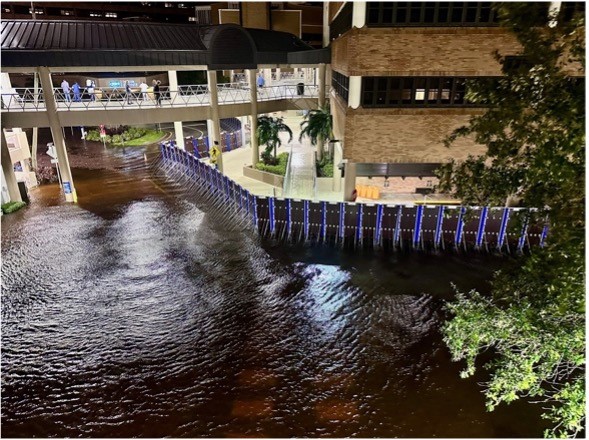Tampa General Hospital, situated on the low-lying Davis Islands in Tampa, Florida, has implemented robust emergency preparedness measures to safeguard its operations during extreme weather events, particularly hurricanes. A key component of their hurricane preparedness plan is the deployment of a flood barrier system, a water-impermeable barrier designed to protect the hospital from storm surges and flooding.
Flood Barrier Deployment and Effectiveness
The deployable flood barrier is reusable and temporary, composed of interlocking panels made from marine-grade laminate, stainless steel, aluminum, and reinforced PVC canvas. These panels are bolted down to resist winds and utilize the weight of floodwater to hold them in place, making them waterproof and puncture-resistant. The system can withstand storm surges up to 15 feet above ground level and wind speeds up to 130 miles per hour, effectively handling Category 3 hurricanes. When not in use, the panels can be conveniently stored flat, making them an ideal and practical solution for facilities like the hospital.
The hospital first invested in the deployable flood barrier system in 2019 as part of its comprehensive emergency preparedness strategy. Situated in a high-risk flood zone, the hospital adopted these necessary measures to ensure continuous operation during adverse weather conditions.
Performance During Hurricanes Helene and Milton
In late September 2024, Hurricane Helene brought record storm surges to the Tampa Bay area, with peak levels topping over seven feet. The flood barrier was deployed around the hospital’s main campus and effectively prevented flooding, allowing the hospital to maintain uninterrupted operations.

Two weeks later, in early October 2024, Hurricane Milton posed an even greater threat, with forecasts predicting storm surges up to 15 feet. The hospital once again deployed the flood barrier, protecting the facility from flooding and storm-related damage. The only Level I trauma center in Tampa was able to remain operational throughout the storm, providing continuous care to patients and supporting the community during the crisis because the flood barriers worked.
Additional Preparedness Measures
Beyond the deployable flood barrier, Tampa General Hospital has implemented several other infrastructure improvements to enhance its resilience against hurricanes:
- Central Energy Plant: Completed in 2022, this 16,000-square-foot facility is located 33 feet above sea level and is designed to withstand the impact and flooding of a Category 5 hurricane. It houses generators and boilers capable of producing steam and hot water, ensuring a reliable power supply during emergencies.
- On-Site Water Resource: The hospital has access to a well that can provide over 5,000 gallons of water, supporting patients and staff during disruptions to municipal water services.
- Emergency Supplies: The hospital maintains a stockpile of more than five days' worth of essential supplies, including food and linens, to ensure sustained operations during and after extreme weather events.
Conclusion
Tampa General Hospital's proactive approach to emergency preparedness, highlighted by deploying the flood barrier system and other critical infrastructure enhancements, has proven effective in maintaining hospital operations during significant hurricanes and floods. These measures protect the facility and ensure it can continue providing essential medical services to the community during and after extreme weather events.

